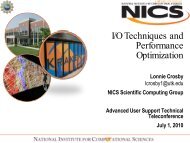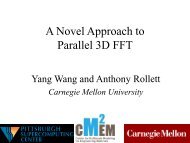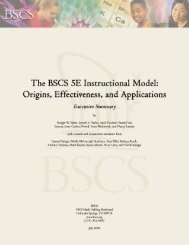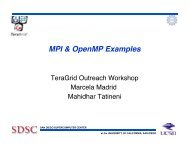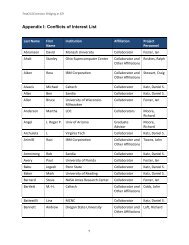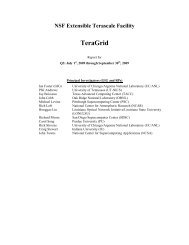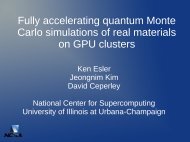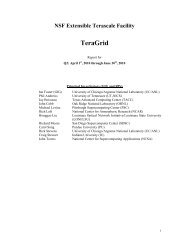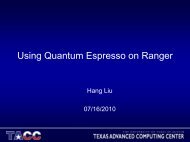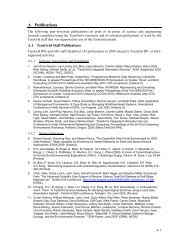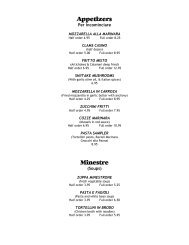TGQR 2010Q4 Report.pdf - Teragridforum.org
TGQR 2010Q4 Report.pdf - Teragridforum.org
TGQR 2010Q4 Report.pdf - Teragridforum.org
Create successful ePaper yourself
Turn your PDF publications into a flip-book with our unique Google optimized e-Paper software.
of the software for an architecture, debugging the software, interaction with and training for users<br />
regarding usage of these codes and software. This is carried out by AUS staff that have Ph.D. and<br />
M.S. level expertise in specific domain sciences and computer science.<br />
5.5.2.2<br />
Projects, decided in collaboration with users, that have the potential to impact large<br />
number of users<br />
Under the second category of ASP efforts, AUS staff work on projects that have the potential to<br />
benefit a large number of users (at least 10 user groups) within a specific domain science or<br />
TeraGrid users in general, utilizing the unique expertise and experience that AUS staff hold. The<br />
projects are identified based on impact it will have on the user community, input from users, input<br />
from AUS staff and other TeraGrid experts. Expertise is available within the AUS staff pool,<br />
across the RP sites, to undertake such projects that have broader impact. AUS staff from multiple<br />
RP sites jointly collaborated on these projects. AUS staff continued to pursue five such projects.<br />
Two of these were pursued by the AUS staff that have domain science as well as HPC expertise<br />
in chemistry/biochemistry and materials science and are users and, in some cases, developers of<br />
molecular dynamics and materials science codes. Large numbers of TeraGrid users use the<br />
molecular dynamics and materials science codes on various TeraGrid machines. The third project,<br />
investigating hybrid programming model, was pursued by AUS staff that has expertise in the area<br />
of HPC programming paradigm. The fourth project involves investigation of PGAS languages<br />
and comparison of performance with MPI based programming models. Initially kernels for linear<br />
system solvers are being explored and later other kernels/codes will be added. AUS staff from<br />
other sites can join once the project progresses. The fifth project involves developing tutorials of<br />
profiling and tracing tools for users.<br />
The first project involved porting, optimizing (using the best compiler options, machine specific<br />
environment variables), benchmarking, and profiling widely used molecular dynamics (MD)<br />
codes on various TG machines. AUS staff from PSC, SDSC, and TACC are participating in this<br />
project. AMBER and NAMD were benchmarked on Ranger and Kraken for various input cases<br />
and utilizing various compiler and environment options. Benchmarks were also done using all the<br />
cores within a node, and partial number of cores within a node to see the impact on performance<br />
and scaling. The results were presented from the AUS benchmark webpage<br />
(https://www.teragrid.<strong>org</strong>/web/user-support/aus_projects) and feedback was received from some<br />
users of these codes. User news was posted to inform the general users about this webpage. As<br />
newer machines, such as the DCL machines, come into production, further benchmarking of MD<br />
codes is ongoing on these machines.<br />
We believe that as such detailed MD benchmark data are made available to the TeraGrid MD<br />
users, it will greatly benefit this large community. In addition to always having the optimally<br />
installed MD codes on various TG machines, this project will enable the MD community to (1)<br />
gain knowledge about performance and scaling characteristics of MD codes on various machines,<br />
(2) know about the optimal compiler and libraries to use on TG machines, (3) install their own<br />
versions of MD codes on TeraGrid machines, and (4) justify resource requests in allocation<br />
proposals. This will also help TRAC reviewers to cross-check users’ requests for resources in<br />
their allocation proposals. The profiling results will be made available to the MD code developers<br />
and enable them to tune the future released versions of the MD codes for TeraGrid machines.<br />
Feedback regarding the usefulness of this project, was sought from about ten prominent long time<br />
TeraGrid MD users and strong support for this project was received from the users.<br />
The second project is similar to the MD project described above and targets codes that are used<br />
more for materials science type simulations, such as VASP, and CPMD. AUS staff, from NCSA,<br />
LONI, PSC and NICS, that have expertise in these codes and in the field of materials science,<br />
carried out this second project. No further activities were needed in this quarter for this project.<br />
62



